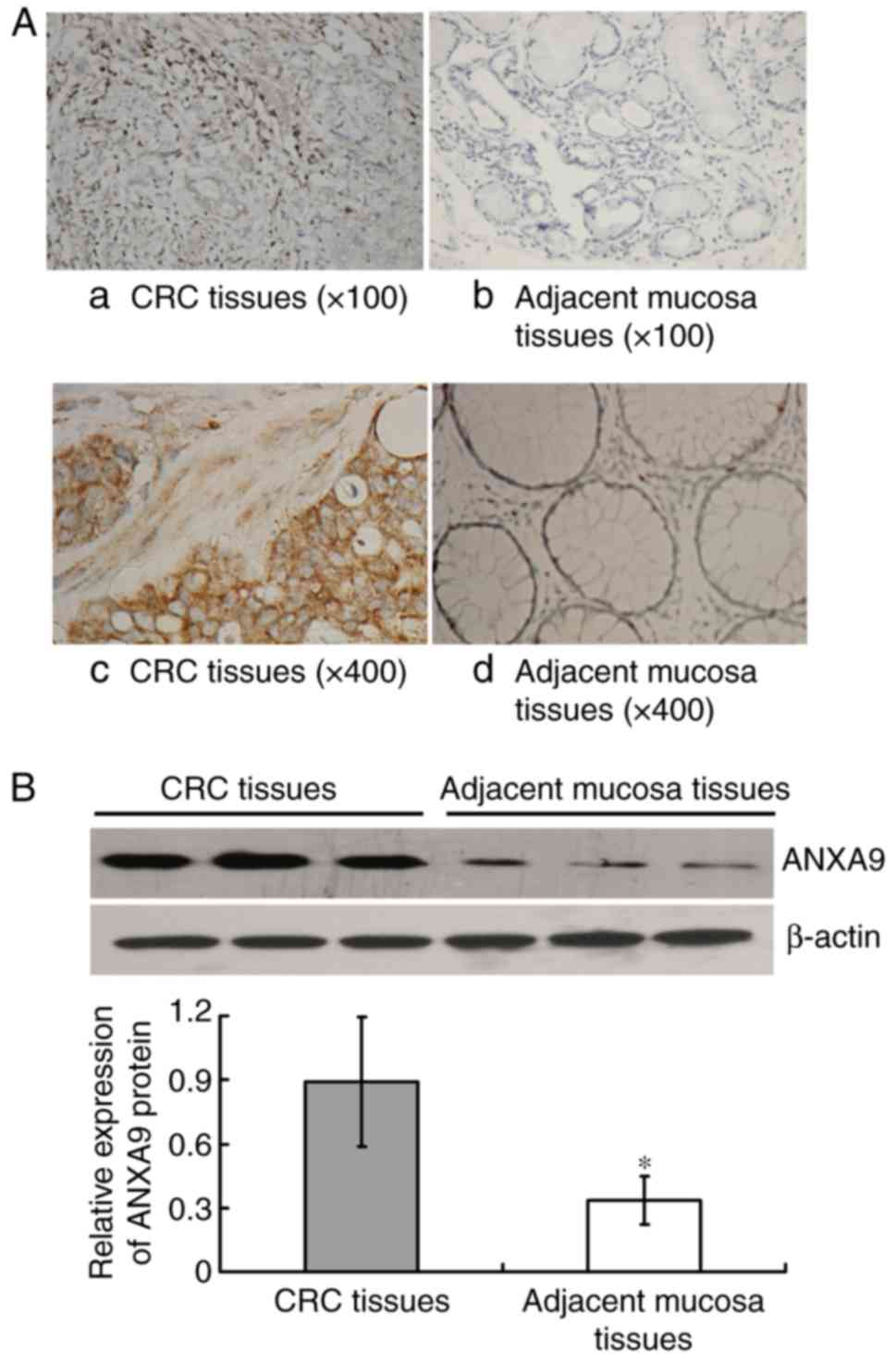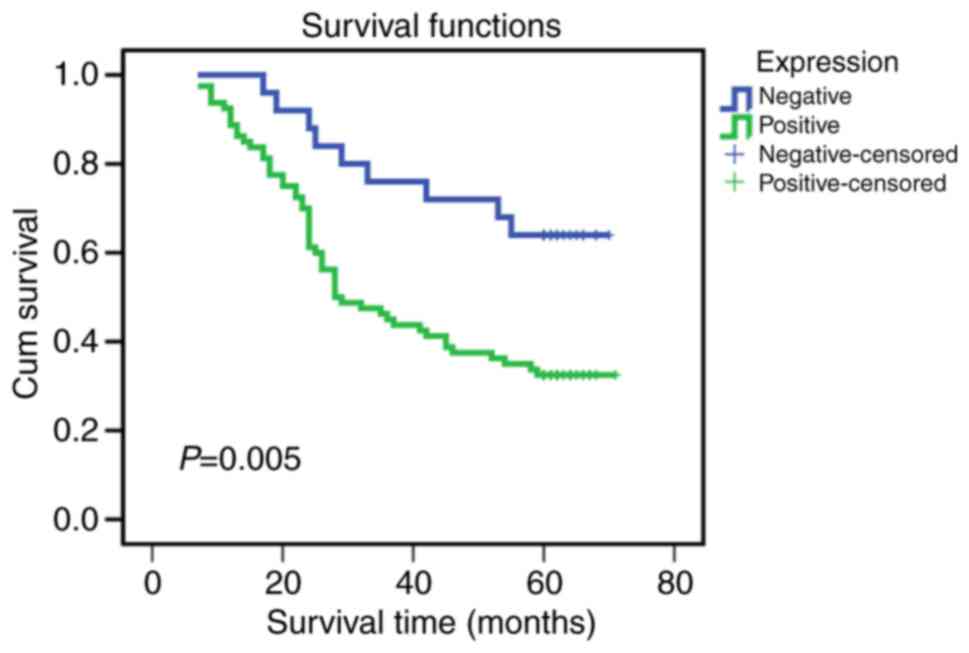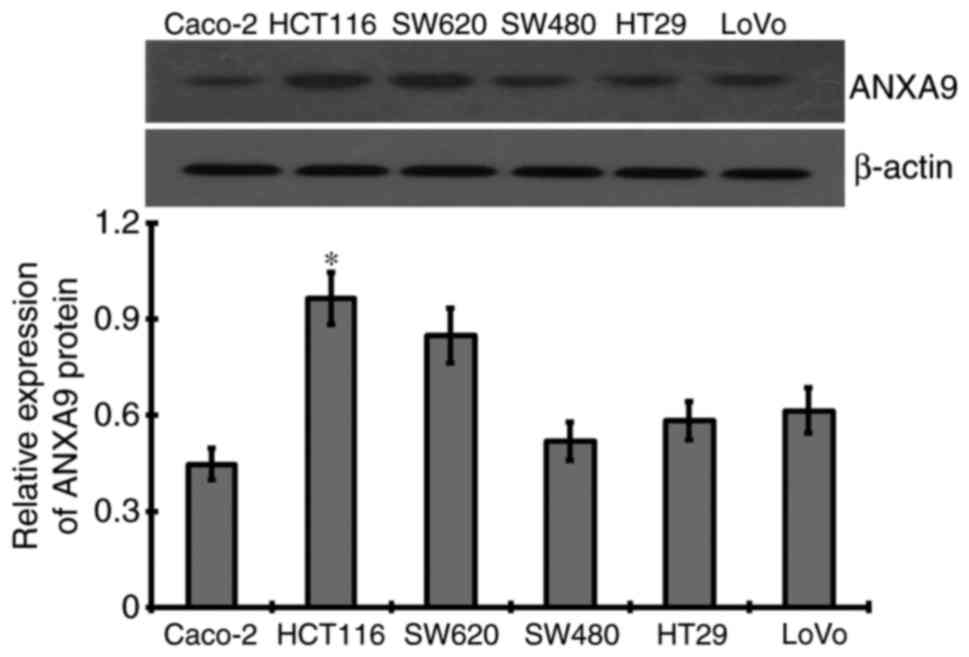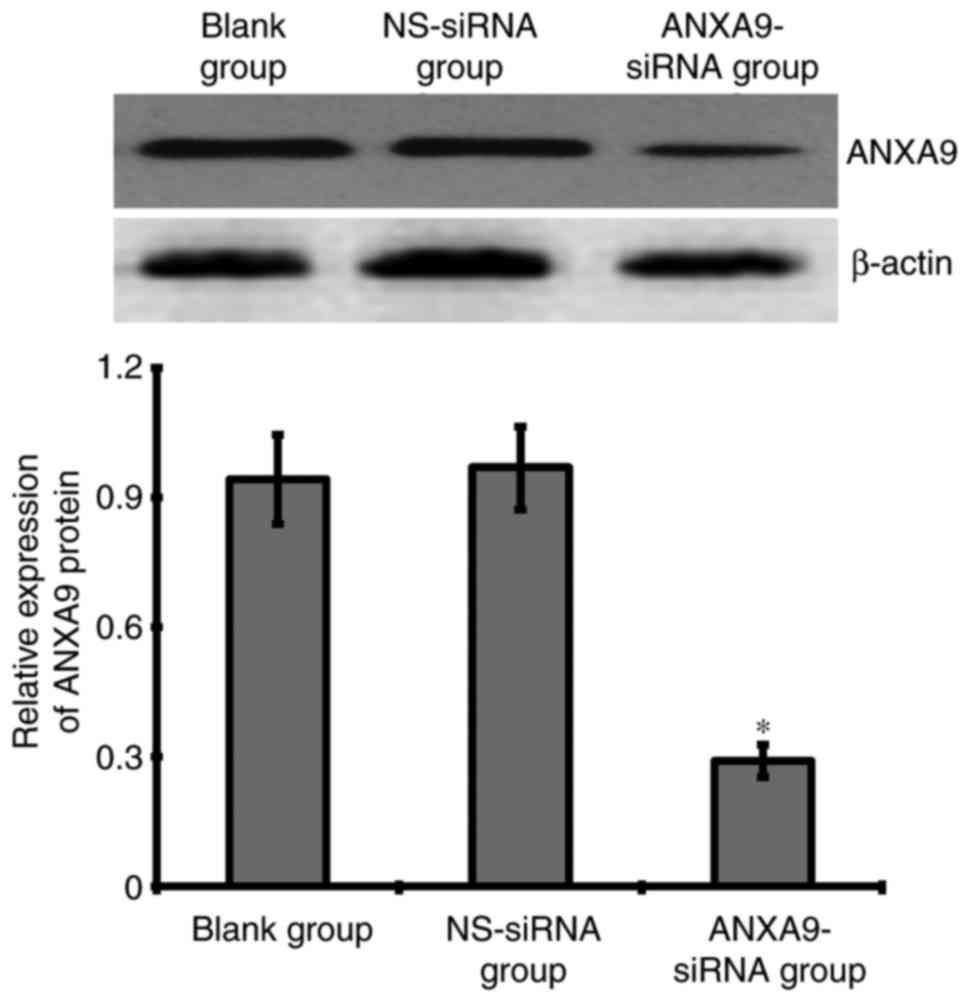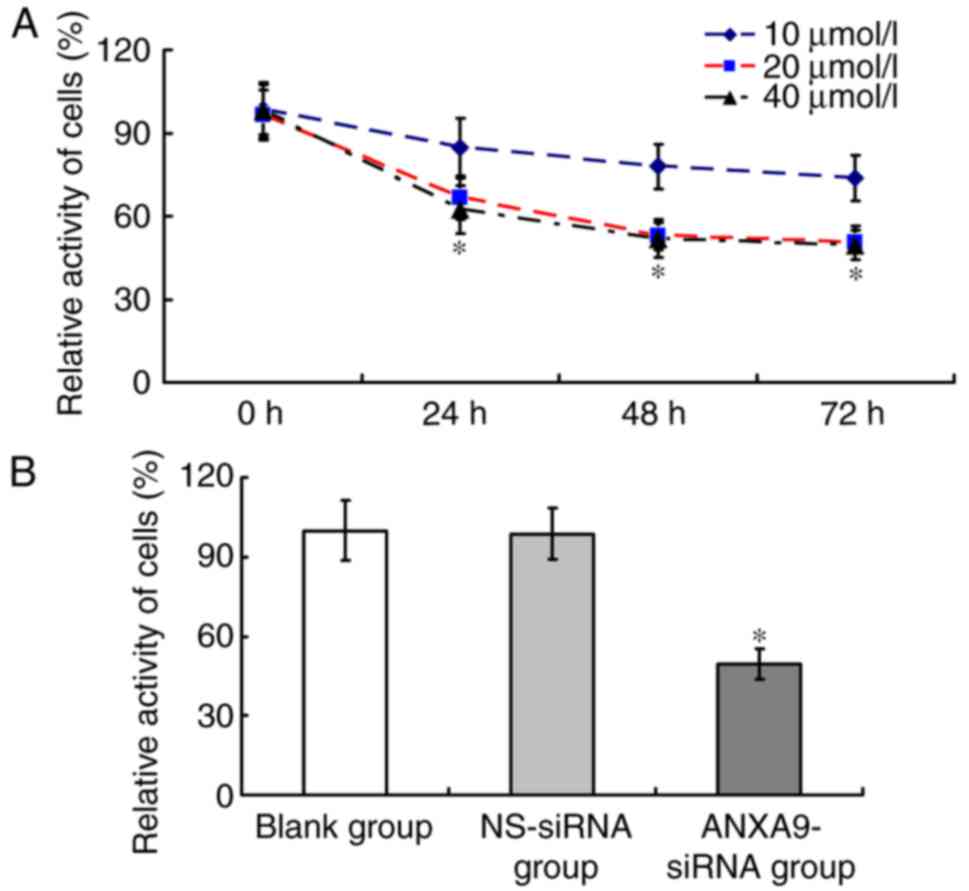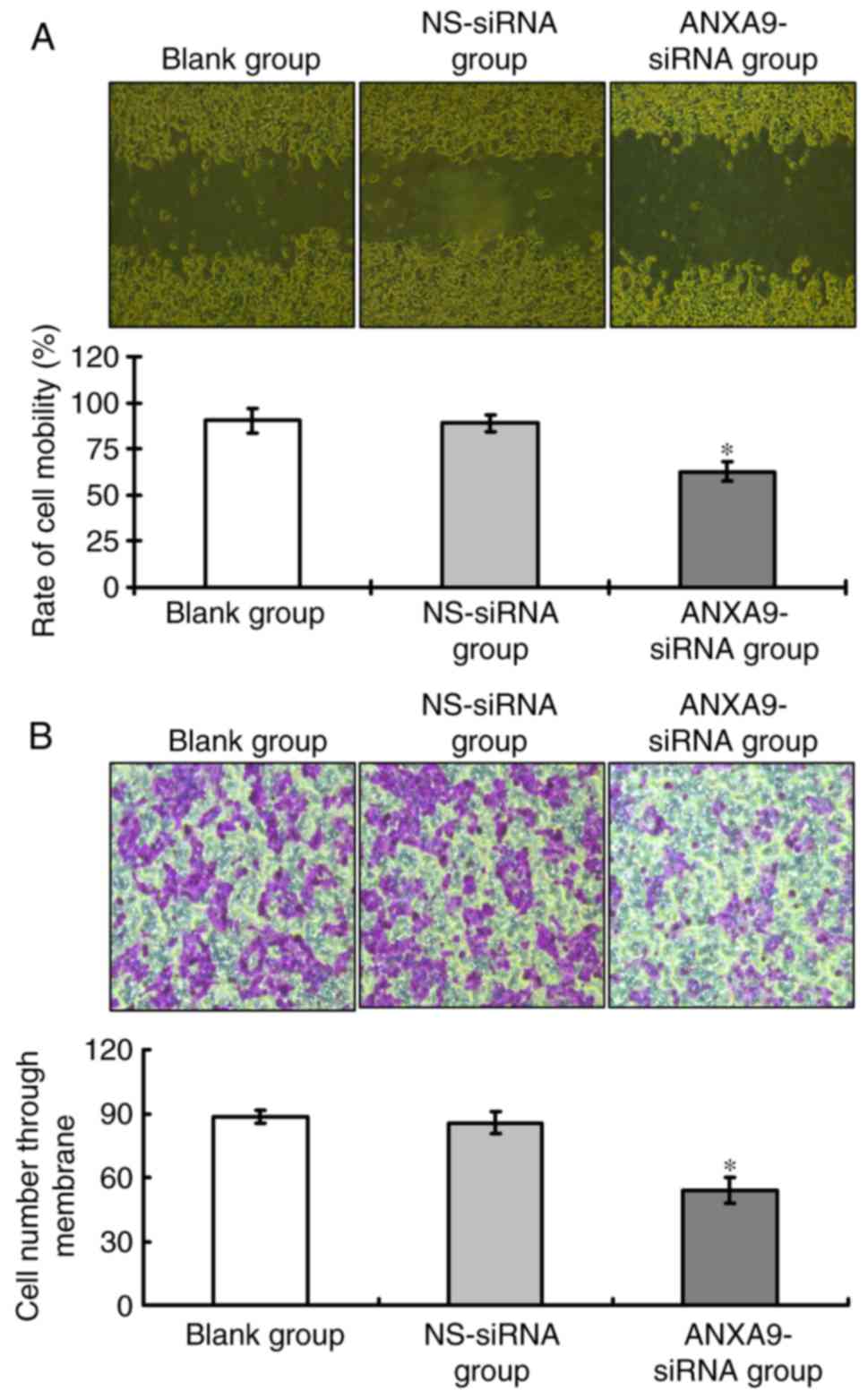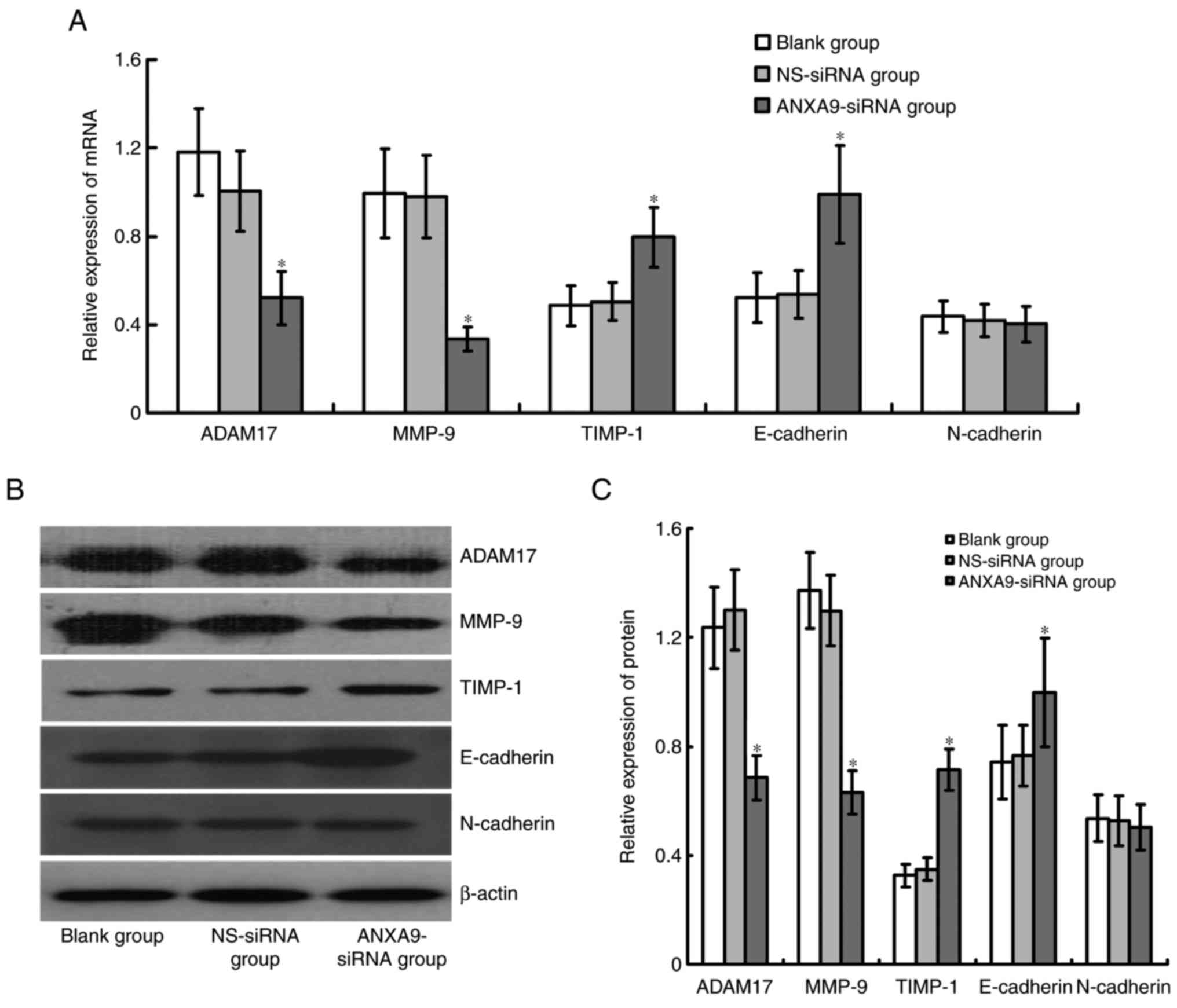Annexin A9 promotes invasion and metastasis of colorectal cancer and predicts poor prognosis
- Authors:
- Published online on: January 29, 2018 https://doi.org/10.3892/ijmm.2018.3432
- Pages: 2185-2192
Abstract
Introduction
Colorectal cancer (CRC), the third most common malignancy worldwide (1), has been treated using combination therapy, including surgery, radiotherapy, chemotherapy and targeted drugs. However, a high proportion of CRC patients were diagnosed in the advanced stage (2), which resulted in poor prognosis and recurrence or metastasis even after treatment. Multiple genes are responsible for this process (3–8); however, the molecular mechanism remains unclear. Therefore, identifying novel genes is considered to be vital for analyzing pathophysiological variations, evaluating medical conditions and defining novel targets in CRC.
Annexins are a group of Ca2+-dependent phospholipid-binding proteins, of which the family members include A, B, C, D and E subgroups. In particular, numerous members of the Annexin A (ANXA) subgroup are closely associated with cancer development (9–11). ANXA9 is a family member of ANXA. A Japanese study demonstrated that expression of ANXA9 mRNA in CRC was associated with a poor prognosis (12), indicating that ANXA9 may be associated with CRC development. However, there are few studies regarding the molecular mechanism of ANXA9 in CRC. The aim of the present study was to investigate the value of ANXA9 protein detection in CRC evaluation and understand the mechanism of ANXA9 in CRC cells. Therefore, in the present study, expression levels of the ANXA9 protein were detected in clinical samples obtained from patients with CRC and the correlation between the ANXA9 protein and clinicopathologic features was analyzed. In addition, the prognosis of the CRC patients was recorded. Furthermore, the variations in CRC cell activity, invasion and migration were investigated under RNA interference by inhibiting ANXA9 expression in HCT116 cells and the alteration of associated genes [ADAM metallopeptidase domain 17 (ADAM17), matrix metallopeptidase 9 (MMP-9), tissue inhibitors of metalloproteinases-1 (TIMP-1), E-cadherin and N-cadherin] was also detected.
Materials and methods
Ethical approval
The study protocol was approved by the Medical Ethics Committee of the Third Hospital of Hebei Medical University (Shijiazhuang, China). All methods used in the present study were performed according to the International Ethical Guidelines for Biomedical Research Involving Human Subjects, and informed consent was obtained from all participants prior to the study.
Participant enrollment
A total of 105 CRC patients whose cancer was removed at The Third Hospital of Hebei Medical University were recruited between January and December 2010. The mean age was 56.36±9.19 year (range, 38–78 years) with 30 females and 75 males. All participants were first diagnosed with CRC without any other malignancies and the diagnosis was conformed by pathological examination. No participants had received radio- or chemotherapy or targeted therapy prior to surgery. Complete clinicopathological data and follow-ups were recorded. TNM Classification of Malignant Tumors was performed according to Union for International Cancer Control/American Joint Committee on Cancer gastric cancer staging system (13). The follow-ups ended in December 2015. Paraffin-embedded samples of tumor tissues and adjacent mucosa (≥2 cm from the edge of the caner with no cancer cells verified) were obtained for the detection of ANXA9 protein expression. Additional fresh samples of tumor tissues and adjacent mucosa were collected from 20 participants who had undergone surgery at The Third Hospital of Hebei Medical University (Shijiazhuang, China) between March and October 2016. These samples were maintained at −80°C and the expression level of ANXA9 proteins were detected by western blotting.
Cell lines and reagents
Human CRC cell lines, Caco-2, HCT116, SW620, SW480 and LOVO were purchased from the Cell Resource Center of Life Sciences (Shanghai, China). Cells from the HT-29 cell line were preserved and incubated at the Scientific Research Center of The Third Hospital of Hebei Medical University (Shijiazhuang, China). Lipofectamine™ 2000 Reagent (Invitrogen; Thermo Fisher Scientific, Inc., USA), Gibco Dulbecco's modified Eagle's medium (DMEM) and Gibco fetal bovine serum (FBS; Thermo Fisher Scientific, Inc.) were applied. In addition, Thiazolyl Blue Tetrazolium Bromide (MTT), TRIzol (Invitrogen; Thermo Fisher Scientific, Inc.), and the quantitative polymerase chain reaction (qPCR) and protein extraction kits (cat. no. PROTTOT) were obtained from Sigma-Aldrich (Merck KGaA, Darmstadt, Germany). The PCR primers and ANXA9-siRNA were designed and synthesized by Sangon Biotech, Co., Ltd. (Shanghai, China). ANXA9 (cat. no. sc-373934), ADAM17 (cat. no. sc-390859), MMP-9 (cat. no. sc-12759), TIMP-1 (cat. no. sc-365905), E-cadherin (cat. no. sc-71008), N-cadherin (cat. no. sc-59987) and β-actin (cat. no. sc-8432) antibodies were obtained from Santa Cruz Biotechnology, Inc. (Dallas, TX, USA).
IHC staining assay
Paraffin specimens were deparaffinized and rehydrated, and immunohistochemical staining of surfactant proteins (S–P) (cat. no. sc-80621) was performed according to the manufacturer's instruction (Santa Cruz Biotechnology, Inc.) Five random visual fields (magnification, ×400; 100 cells per field) for each section were evaluated by pathologists. Expression levels of the ANXA9 protein were determined as positive if yellow or brown plasmids were observed in the cytoplasm or on the cell membrane. Expression positivity was scored as follows: i) Darkness of staining (transparent, 0; light yellow, 1; brownish-yellow, 2; and brown, 3; ii) ratio of positive to negative cells (positivity of 0%, 0; ≤10%, 1; 11–50%, 2; 51–75%, 3; and >75%). The two scores were added and ≤2 was considered to be negative (−) and >2 was considered to be positive (+).
Western blot assay
Tissue and cell lysates were prepared with lysis buffer [1% Triton X-100, 150 mM NaCl, 10 mM Tris-HCl (pH 7.4), 1 mM ethylene diamine tetraacetic acid (EDTA), 1 mM ethylene glycol-bis(β-aminoethylether)tetraacetic acid (pH 8.0), 0.2 mM Na3VO4, 0.2 mM phenylmethylsulfonyl fluoride, and 0.5% NP-40]. The samples were rinsed in ice-cold lysis buffer for 20 min followed by centrifugation for 10 min at 7,104 × g at 4°C. The supernatant was collected and the bicinchoninic acid assay was performed for quantitation of protein. Equal quantities of protein (60 µg) from each sample were separated in 10% dodecyl sulfate, sodium salt-polyacrylamide gel electrophoresis gels and electrotransferred to polyvinylidene difluoride membranes (100 V, 2 h). The membranes were blocked in 5% non-fat milk for 2 h at room temperature, followed by incubation in diluted antibodies at 4°C overnight. The following antibodies were used: Mouse anti-ANXA9 (1:200, cat. no. sc-373934), mouse anti-ADAM17 (1:200, cat. no. sc-390859), mouse anti-MMP-9 (1:400, cat. no. sc-12759), mouse anti-TIMP-1 (1:200, cat. no. sc-365905), mouse anti-E-cadherin (1:200, cat. no. sc-71008), mouse anti-N-cadherin (1:800, cat. no. sc-59987), mouse anti-β-actin (1:200, cat. no. sc-8432) all Santa Cruz Biotechnology, Inc. Following three rinses with Tris-Hcl, NaCl and Tween-20 (TBST), blots were incubated with peroxidase-conjugated donkey anti-mouse antibody (1:2,000; cat. no. AB10085; Jackson ImmunoResearch Laboratories, Inc., West Grove, PA, USA) for 2 h at room temperature. After three rinses with TBST and one with TBS, the optical density (OD) of the bands was detected using an enhanced chemiluminescence detection system. The concentration of proteins in the samples was then determined by comparing the OD of the samples to the standard curve.
Cell culture
All cell lines were cultured in DMEM supplemented with 10% FBS, 100 U/ml penicillin and 0.1 mg/ml streptomycin. Cells were maintained at 37°C in an incubator saturated with 5% CO2. Cells were dissociated with 0.25% trypsin containing 0.02% EDTA and were passaged. Cells in the exponential growth phase were used for the experiments.
ANXA9-siRNA transfection
Design and synthesis of the sequence of siRNA targeting ANXA9 was performed as below: siRNA, 5′-GCAGUCUACAAACACAAUUtt-3′ and non-specific control siRNA (NS-siRNA), 5′-UUCUCCGAACGUGUCACGUtt-3′. HCT116 cells were transplanted into 6-well plates 24 h prior to transfection (density of 1×106 cells/ml). Plasmid transfection was performed using Lipofectamine™ 2000 according to the manufacturer's instructions after samples were washed with serum- and antibody-free DMEM. Efficiency of transfection and ANXA9 suppression was detected 24 h after transfection. Experimental samples were divided into three groups according to the transfection status, which were the Lipofectamine™ 2000 transfected group (blank group), NS-siRNA transfected group (NS-siRNA group) and the ANXA9-siRNA transfected group (ANXA9-siRNA group).
RNA extraction and qPCR
Total cellular RNA in the tissue specimens and cells of different groups was extracted using TRIzol (Invitrogen; Thermo Fisher Scientific, Inc.) according to the manufacturer's protocol. qPCR was performed in a total volume of 20 µl containing 1 µl reverse transcription product as a template for PCR, 2X UltraSYBR mixture (10 µl; Applied Biosystems; Thermo Fisher Scientific, Inc.), 10 µmol/l per 1 µl primer, 8 µl DNase/RNase-Free water. The primer sequences used in PCR are presented in Table I. PCR was performed over 35 cycles as follows: Initial denaturation at 95°C for 5 min, denaturation at 95°C for 30 sec, annealing at 60°C for 30 sec and elongation at 72°C for 30 sec. Fluorescence was detected at the end of each cycle. The specificity of the products was confirmed by melting curve analysis. GAPDH served as an endogenous reference to standardize relative expression levels for data analysis to calculate the expression levels.
MTT assay
Cells were incubated in 96-well plates at a density of 1×105 cells/ml. When the cell density reached 70–80% confluence, ANXA9-siRNA or NS-siRNA was transfected. The cells were plated in 6 replicate wells per cell density. Following incubation at 37°C for 20 h, 20 µl (5 mg/ml) MTT was added for another 4-h incubation and discarded, followed by the addition of 150 µl DMSO in each well and gentle shaking at room temperature for 15 min. The OD value was measured at a wavelength of 490 nm using a microplate spectrophotometer. Each treatment was performed in triplicate.
Wound healing assay
HCT116 cells were formed into mono-layer suspension (density, 1×106 cell/ml) and seeded in each well of 6-well culture plates. The cells were transfected with ANXA9-siRNA or NS-siRNA at 60–70% confluence and cultured until 100%. The culture medium was removed and the cells were rinsed with phosphate-buffered saline (PBS). This monolayer was then scored using a sterile pipette tip to form scratches and was rinsed with PBS again to remove any dislodged cells. Wound closure was visualized using a microscope. The procedures were performed in triplicate.
Transwell assay
Each well in the upper chamber was coated with 100 µl Matrigel (BD Biosciences, Franklin Lakes, NJ, USA) under ultraviolet light. HCT116 cells were suspended and plated at 1×106 cells/ml in 6-well plates. These cells were cultured until 60–70% confluence for transfection. After a 24-h incubation at 37°C, 200 µl cells were extracted from each group and plated in the upper chamber of a Transwell, while DMEM was added to the lower chamber. After removing any excess Matrigel and non-invading cells from the upper chamber, the Transwell membranes were fixed in methanol for 10 min and stained with crystal violet for 30 min at 37°C. Cells on the underside of the membranes that had invaded the Matrigel were counted under an inverted microscope (Carl Zeiss AG, Oberkochen, Germany). The treatment was repeated three times.
Statistical analysis
All of the data was analyzed by SPSS 26.0 statistical software (IBM Corp., Armonk, NY, USA). Quantitative data was represented as the mean ± standard deviation, and the deviation between groups was analyzed using one way analysis and Dunnett t-test and variation analysis. Categorical data were expressed as percentages and analyzed using the χ2 test. Kaplan-Meier analysis and COX's proportional hazard regression model were utilized to investigate the prognostic factors of the ANXA9 protein. P<0.05 was considered to indicate a statistically significant difference.
Results
Expression levels of ANXA9 in CRC tissues and adjacent mucosa
The IHC result demonstrated that the positive rate of ANXA9 protein expression in CRC tissue samples was higher than that in the adjacent mucosa with 76.19% (80/105), and 16.19% (17/105), respectively (χ2=76.041; P<0.001), as illustrated in Fig. 1A. Similarly, the result of western blot analysis demonstrated that the ANXA9 expression level was higher in CRC tissues compared with the adjacent mucosa (P<0.001) (Fig. 1B).
Association between expression levels of ANXA9 in CRC tissue and clinicopathological characteristics with CRC patients
The result demonstrated that a higher ANXA9 positive rate presented deeper-infiltration and lymphatic metastasis in the CRC tissue samples (P<0.05), and no significant correlation was identified between ANXA9 and other clinicopathological parameters (P>0.05). The results were illustrated in Table II.
Table IIAssociation between ANXA9 protein and clinicopathological parameters in CRC patients (n=105). |
Prognostic value of ANXA9 detection for CRC patients
The association between ANXA9 expression levels and prognosis was analyzed and presented using a Kaplan-Meier survival curve (Fig. 2). The data demonstrates that the overall survival rate was lower in the patients with positive ANXA9 expression compared with those with negative ANXA9 expression (P=0.005). According to Cox's proportional hazards regression model presented in Table III, the present study illustrated that ANXA9 expression level was an independent risk factor in CRC prognosis (P=0.022), and other independent risk factors, including lymphatic metastasis, differentiation and distant metastasis (P=0.017, 0.021 and 0.026, respectively).
ANXA9 expression levels in CRC cell lines
As a result of western blotting, different levels of ANXA9 protein were detected in six CRC cell lines, among which the highest expression level of ANXA9 protein was demonstrated in HCT116 cells, and thus was selected for subsequent experiments (Fig. 3).
Effect of ANXA9-siRNA on ANXA9 protein in HCT116 cells
The result of western blotting demonstrated that after a 48-h transfection with 20 µmol/l ANXA9-siRNA, the ANXA9 expression level was downregulated more significantly when compared with the NS-siRNA and blank groups (Fig. 4).
Impact of ANXA9-siRNA on activity of HCT116 cells
The cell activity of the ANXA9-siRNA group varied with different concentrations and durations (Fig. 5A). Following transfection with ANXA9-siRNA (20 µmol/l) for 48 h, the cell activity of the ANXA9-siRNA group (49.64±5.82%) was significant lower than that in the NS-siRNA group (98.62±9.69%) and the blank group (100±11.24%; P<0.05), as demonstrated in Fig. 5B.
Effect of ANXA9-siRNA on migration and invasion activities in HCT116 cells
Results of the wound healing assay (Fig. 6A) and Transwell assay (Fig. 6B) demonstrate that, following ANXA9-siRNA transfection, the migration and invasion of HCT116 cells treated with ANXA9-siRNA were significantly decreased when compared with the NS-siRNA group and the blank group (P<0.05), as shown in Fig. 6.
Effect of ANXA9-siRNA on expression levels of ADAM17, MMP-9, TIMP-1, E-cadherin and N-cadherin in HCT116 cells
Expression levels of ADAM17 and MMP-9 mRNA and proteins were significantly downregulated, while TIMP-1 and E-cadherin mRNA and protein expression levels were significantly upregulated in HCT116 cells following ANXA9-siRNA transfection (P<0.05), and no obvious variation was observed in N-cadherin following ANXA9-siRNA transfection (P>0.05; Fig. 7).
Discussion
The incidence of CRC has increased in recent years (14) and has unsatisfactory treatment outcomes. Although certain risk factors of CRC have been identified in terms of diet (15,16), environment (17) and genetics (18), factors that determine the risk of disease remain poorly understood. In the early stages, the symptoms of CRC are often insidious; therefore patients with CRC are typically diagnosed at the advanced stage with a relatively rapid progression and metastases. One of the reasons for the rapid progression of CRC is the strong ability of the cancerous cells to invade and metastasize (3,4). Therefore, suppression of invasion and metastasis of CRC cells may contribute to improvement of the treatment of this illness. Multiple genes and signaling pathways are important in the progression of CRC (5–8,19,20), including various members of the ANXA family. Zhang et al (21) demonstrated that non-steroid anti-inflammatory drugs affect the activity of the nuclear factor-κB signaling pathway resulting in ANXA1 inhibition, which may lead to growth suppression of CRC cells. In the study by Yang et al (22), ANXA2 was verified to be correlated with the clinicopathological characteristics of CRC. Miyoshi et al (12) reported that a high expression level of ANXA9 mRNA was a marker of poor prognosis for CRC. These studies indicate that ANXAs are significantly associated with CRC development. However, to the best of our knowledge, the association between the ANXA9 gene and CRC has only been examined in one study and only the mRNA expression level of clinical value was reported (12).
In the present study, the clinical value of ANXA9 expression in patients with CRC was investigated in cancer and adjacent mucosa tissue samples (obtained from 105 patients) using IHC. The results demonstrated that a positive ANXA9 expression rate in the cancer tissue samples was higher than that in the mucosal tissue samples. Furthermore, the western blot result was consistent with the IHC result, indicating that ANXA9 may be involved in carcinogenesis development and progression. In addition, further analysis demonstrated that ANXA9 was associated with tumor infiltration depth and lymphatic metastasis, implying that ANXA9 may contribute to CRC invasion and migration. Furthermore, prognostic analysis demonstrated a lower survival rate in the patients with positive ANXA9 protein expression, which was also an independent risk factor for patient survival. These results indicated that ANXA9 protein may be significant in prognostic evaluation, as well as being a marker of poor prognosis with positive expression.
The ANXA9 gene (size, 8,233 bp) is located in human chromosome 1q21, contains 14 exons and encodes 345 amino acid chains (23,24). The association between ANXA9, and CRC cell invasion and migration has not yet been defined. Our further aim is therefore to analyze the function of ANXA9 in CRC invasion and metastasis using RNA interference technology to suppress ANXA9 expression of HCT116 cells in CRC. The present study demonstrated that ANXA9 inhibition resulted in a significant decrease in HCT116 cell proliferation, as well as decreased ability of invasion and migration. In order to understand the molecular mechanism of regulation by ANXA9, the changes of ADAM17, MMP-9 and TIMP-1 expression levels were detected in HCT116 cells folloing inhibition of ANXA9 expression. ADAM17 is a family members of disintegrin and metalloprotease, of which the upregulated expression in CRC participates in tumor progression (25). Furthermore, a previous study demonstrated that suppression of ADAM17 expression in the CRC cell, MC38CEA results in inhibition of activity and migration (26). MMP-9, an important member of the MMP family, is significant in CRC progression (27,28), whereas TIMP-1 (an MMP-9 suppressor) inhibits MMP-9 and therefore decreases the ability of cancerous cells to invade and migrate (29,30). The present study demonstrated that inhibitation of ANXA9 expression resulted in reduction of ADAM17 expression levels, whereas the level of MMP-9 expression increased in TIMP-1. In addition, ANXA9 was identified to be correlated with ADAM17, where MMP-9 is downregulated by mediation of ADAM17 (31). These results indicate that inhibition of ANXA9 expression levels in HCT116 cells may induce suppression of ADMA17 and MMP-9 expression levels, but increase the TIMP-1 expression level contributing to the weakness of tumor cells in invasion and migration (26,32). Epithelial-mesenchymal transition (EMT) contributes to the invasion and migration of CRC (33). E-cadherin and N-cadherin are important in EMT of CRC (34,35). The results of the current study demonstrate that E-cadherin was upregulated after ANXA9 inhibition, whereas no obvious variation was verified in N-cadherin. To better understand the association between ANXA9 and CRC, further studies at the molecular level are required.
In conclusion, the present study demonstrates that ANXA9 may be a novel marker of poor prognosis. Inhibition of ANXA9 expression may suppress the activity, invasion and metastasis of CRC cells by regulating ADAM17, MMP-9, TIMP-1 and E-cadherin. This indicates that ANXA9 may be associated with invasion and metastasis of CRC. Thus, the current study may provide evidence for further research into CRC development, prognostic markers and gene targeted therapeutic strategies.
Notes
[1] Competing interests
The authors declare that they have no competing interests.
References
|
Schreuders EH, Ruco A, Rabeneck L, Schoen RE, Sung JJ, Young GP and Kuipers EJ: Colorectal cancer screening: A global overview of existing programmes. Gut. 64:1637–1649. 2015. View Article : Google Scholar : PubMed/NCBI | |
|
Mol L, Ottevanger PB, Koopman M and Punt CJ: The prognostic value of WHO performance status in relation to quality of life in advanced colorectal cancer patients. Eur J Cancer. 66:138–143. 2016. View Article : Google Scholar : PubMed/NCBI | |
|
van Wyk HC, Roxburgh CS, Horgan PG, Foulis AF and McMillan DC: The detection and role of lymphatic and blood vessel invasion in predicting survival in pa'tients with node negative operable primary colorectal cancer. Crit Rev Oncol Hematol. 90:77–90. 2014. View Article : Google Scholar | |
|
Ning Y and Lenz HJ: Targeting IL-8 in colorectal cancer. Expert Opin Ther Targets. 16:491–497. 2012. View Article : Google Scholar : PubMed/NCBI | |
|
Wu M, Wang J, Tang W, Zhan X, Li Y, Peng Y, Huang X, Bai Y, Zhao J, Li A, et al: FOXK1 interaction with FHL2 promotes proliferation, invasion and metastasis in colorectal cancer. Oncogenesis. 5:e2712016. View Article : Google Scholar : PubMed/NCBI | |
|
Jeong SH, Jeon YJ and Park SJ: Inhibitory effects of dieckol on hypoxia-induced epithelial-mesenchymal transition of HT29 human colorectal cancer cells. Mol Med Rep. 14:5148–5154. 2016. View Article : Google Scholar : PubMed/NCBI | |
|
Kim BR, Kang MH, Kim JL, Na YJ, Park SH, Lee SI, Kang S, Joung SY, Lee SY, Lee DH, et al: RUNX3 inhibits the metastasis and angiogenesis of colorectal cancer. Oncol Rep. 36:2601–2608. 2016. View Article : Google Scholar : PubMed/NCBI | |
|
Shi W, Ye Z, Zhuang L, Li Y, Shuai W, Zuo Z, Mao X, Liu R, Wu J, Chen S and Huang W: Olfactomedin 1 negatively regulates NF-κB signalling and suppresses the growth and metastasis of colorectal cancer cells. J Pathol. 240:352–365. 2016. View Article : Google Scholar : PubMed/NCBI | |
|
Boudhraa Z, Bouchon B, Viallard C, D'Incan M and Degoul F: Annexin A1 localization and its relevance to cancer. Clin Sci. 130:205–220. 2016. View Article : Google Scholar : PubMed/NCBI | |
|
Qi H, Liu S, Guo C, Wang J, Greenaway FT and Sun MZ: Role of Annexin A6 in cancer. Oncol Lett. 10:1947–1952. 2015. View Article : Google Scholar : PubMed/NCBI | |
|
Lauritzen SP, Boye TL and Nylandsted J: Annexins are instrumental for efficient plasma membrane repair in cancer cells. Semin Cell Dev Biol. 45:32–38. 2015. View Article : Google Scholar : PubMed/NCBI | |
|
Miyoshi N, Yamamoto H, Mimori K, Yamashita S, Miyazaki S, Nakagawa S, Ishii H, Noura S, Ohue M, Yano M, et al: ANXA9 gene expression in colorectal cancer: A novel marker for prognosis. Oncol Lett. 8:2313–2317. 2014. View Article : Google Scholar : PubMed/NCBI | |
|
Edge SB and Compton CC: The American Joint Committee on Cancer: The 7th edition of the AJCC cancer staging manual and the future of TNM. Ann Surg Oncol. 17:1471–1474. 2010. View Article : Google Scholar : PubMed/NCBI | |
|
Bode AM, Dong Z and Wang H: Cancer prevention and control: Alarming challenges in China. Natl Sci Rev. 3:117–127. 2016. View Article : Google Scholar : PubMed/NCBI | |
|
Liu J, Zhou Q, Xu J, Wang J and Zhang Y: Detection of EGFR expression in patients with colorectal cancer and the therapeutic effect of cetuximab. J BUON. 21:95–100. 2016.PubMed/NCBI | |
|
Bhopal RS: Diet and colorectal cancer incidence. JAMA Intern Med. 175:1726–1727. 2015. View Article : Google Scholar : PubMed/NCBI | |
|
Marley AR and Nan H: Epidemiology of colorectal cancer. Int J Mol Epidemiol Genet. 7:105–114. 2016.PubMed/NCBI | |
|
Cai Z, Han S, Li Z, He L, Zhou J, Huang W and Xu Y: A genome-wide assessment of variations of primary colorectal cancer maintained in metastases. Gene. 595:18–24. 2016. View Article : Google Scholar : PubMed/NCBI | |
|
Wang H, Xi Q and Wu G: Fatty acid synthase regulates invasion and metastasis of colorectal cancer via Wnt signaling pathway. Cancer Med. 5:1599–1606. 2016. View Article : Google Scholar : PubMed/NCBI | |
|
Zou F, Mao R, Yang L, Lin S, Lei K, Zheng Y, Ding Y, Zhang P, Cai G, Liang X and Liu J: Targeted deletion of miR-139-5p activates MAPK, NF-κB and STAT3 signaling and promotes intestinal inflammation and colorectal cancer. FEBS J. 283:1438–1452. 2016. View Article : Google Scholar : PubMed/NCBI | |
|
Zhang Z, Huang L, Zhao W and Rigas B: Annexin 1 induced by anti-inflammatory drugs binds to NF-kappaB and inhibits its activation: Anticancer effects in vitro and in vivo. Cancer Res. 70:2379–2388. 2010. View Article : Google Scholar : PubMed/NCBI | |
|
Yang T, Peng H, Wang J, Yang J, Nice EC, Xie K and Huang C: Prognostic and diagnostic significance of Annexin A2 in colorectal cancer. Colorectal Dis. 15:e373–e381. 2013. View Article : Google Scholar : PubMed/NCBI | |
|
Boczonadi V and Määttä A: Annexin A9 is a periplakin interacting partner in membrane-targeted cytoskeletal linker protein complexes. FEBS Lett. 586:3090–3096. 2012. View Article : Google Scholar : PubMed/NCBI | |
|
Goebeler V, Ruhe D, Gerke V and Rescher U: Atypical properties displayed by annexin A9, a novel member of the annexin family of Ca2+ and lipid binding proteins. FEBS Lett. 546:359–364. 2003. View Article : Google Scholar : PubMed/NCBI | |
|
Blanchot-Jossic F, Jarry A, Masson D, Bach-Ngohou K, Paineau J, Denis MG, Laboisse CL and Mosnier JF: Up-regulated expression of ADAM17 in human colon carcinoma: Co-expression with EGFR in neoplastic and endothelial cells. J Pathol. 207:156–163. 2005. View Article : Google Scholar : PubMed/NCBI | |
|
Das S, Czarnek M, Bzowska M, Mężyk-Kopeć R, Stalińska K, Wyroba B, Sroka J, Jucha J, Deneka D, Stokłosa P, et al: ADAM17 silencing in mouse colon carcinoma cells: The effect on tumoricidal cytokines and angiogenesis. PLoS One. 7:e507912012. View Article : Google Scholar : PubMed/NCBI | |
|
Lima AI, Mota J, Monteiro SA and Ferreira RM: Legume seeds and colorectal cancer revisited: Protease inhibitors reduce MMP-9 activity and colon cancer cell migration. Food Chem. 197:30–38. 2016. View Article : Google Scholar | |
|
Liu F, Zhang T, Zou S, Jiang B and Hua D: B7-H3 promotes cell migration and invasion through the Jak2/Stat3/MMP9 signaling pathway in colorectal cancer. Mol Med Rep. 12:5455–5460. 2015. View Article : Google Scholar : PubMed/NCBI | |
|
Weidle UH, Birzele F and Krüger A: Molecular targets and pathways involved in liver metastasis of colorectal cancer. Clin Exp Metastasis. 32:623–635. 2015. View Article : Google Scholar : PubMed/NCBI | |
|
Christensen IJ, Brünner N, Dowell B, Davis G, Nielsen HJ, Newstead G and King D: Plasma TIMP-1 and CEA as markers for detection of primary colorectal cancer: A prospective validation study including symptomatic and non-symptomatic individuals. Anticancer Res. 35:4935–4941. 2015.PubMed/NCBI | |
|
Nakayama H, Fukuda S, Inoue H, Nishida-Fukuda H, Shirakata Y, Hashimoto K and Higashiyama S: Cell surface annexins regulate ADAM-mediated ectodomain shedding of proamphiregulin. Mol Biol Cell. 23:1964–1975. 2012. View Article : Google Scholar : PubMed/NCBI | |
|
Xiao LJ, Lin P, Lin F, Liu X, Qin W, Zou HF, Guo L, Liu W, Wang SJ and Yu XG: ADAM17 targets MMP-2 and MMP-9 via EGFR-MEK-ERK pathway activation to promote prostate cancer cell invasion. Int J Oncol. 40:1714–1724. 2012. | |
|
Li Q, Wang Y, Lai Y, Xu P and Yang Z: HspB5 correlates with poor prognosis in colorectal cancer and prompts epithelial-mesenchymal transition through ERK signaling. PLoS One. 12:e01825882017. View Article : Google Scholar : PubMed/NCBI | |
|
Iseki Y, Shibutani M, Maeda K, Nagahara H, Ikeya T and Hirakawa K: Significance of E-cadherin and CD44 expression in patients with unresectble metastatic colorectal cancer. Oncol Lett. 14:1025–1034. 2017. View Article : Google Scholar : PubMed/NCBI | |
|
Yan X, Yan L, Liu S, Shan Z, Tian Y and Jin Z: N-cadherin, a novel prognostic biomarker, drives malignant progression of colorectal cancer. Mol Med Rep. 12:2999–3006. 2015. View Article : Google Scholar : PubMed/NCBI |



